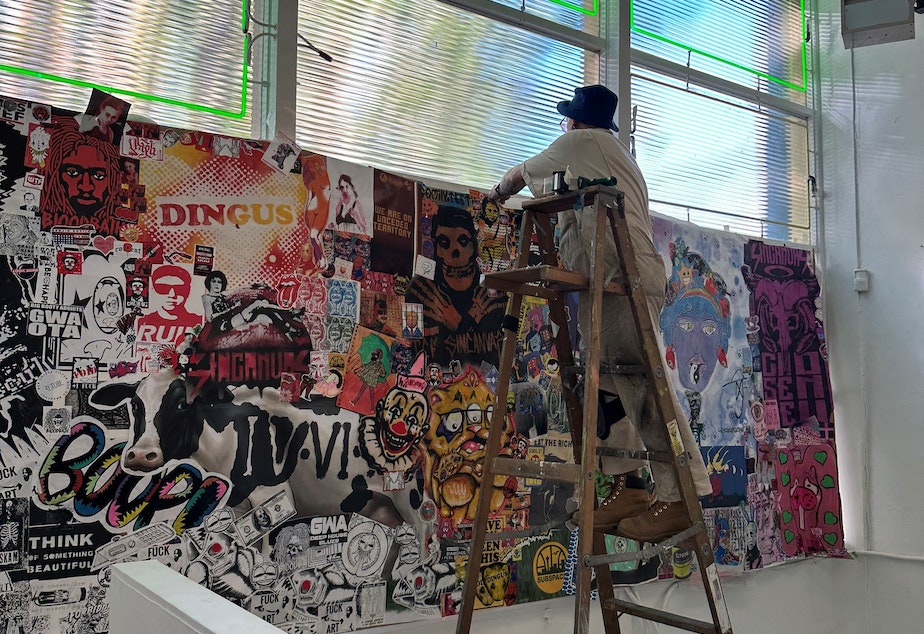If you’re looking for tips on how to experience art in the Seattle area, you’re in the right place. In this weekly post, KUOW reporter Mike Davis has suggestions for what to do around Seattle over the weekend so you can have your own adventures in arts and culture.
Visual Art
‘Toys Not Included: Seattle Street Art Show‘ is showing at Base Camp Studios in Belltown. This show is one I’m excited to see. For people like me, who walk around noticing all the street art in our city, this show is for us.
Artist and curator of this exhibit, GirlSpit, brought together over 30 people who create the art found in public spaces throughout Seattle, and gathered their pieces for a one-of-kind exhibit.
While many of the artists in this show have never sold any of their work before, some have pieces available online. The thread that ties this exhibit together is the ability to view and purchase pieces which are typically only found out in the wild in a gallery setting, as well as the opportunity to meet many of the artists in person. The opening event will also include live music.
I’m looking forward to seeing the Lego-brick hearts from artist Jaw and the chance to snag some stickers from Starheadboy.

‘Toys Not Included’ opens at Base Camp Studios on Aug. 5 from 4 to 7 p.m. and can also be viewed during Belltown Art Walk.
‘Renegade Edo and Paris: Japanese Prints and Toulouse-Lautrec‘ is showing at the Seattle Asian Art Museum. I want to give some background on this exhibit, but I assure you — the art on display is cool enough to not even need all the background explanations. These pieces are beautiful!
Nevertheless, here’s the story behind the curation. In 18th and 19th century Edo, or Tokyo, society was in a period of leisure. There was no war or famine, and the middle class was rapidly growing. Parisian society was in a similar place and the art emerging from these two cities shared many parallels — artists in Paris were influenced by the art in Edo.
With the boom in the middle class, there was a growing interest in theater and leisurely activities. In Edo it was the teahouses; in Paris, the brothels. The artists in each city created works that reflected these social activities and this expansive collection at the Asian Art Museum captures the works created during this era.
Artists in both cities spent time in teahouses and brothels, respectively, and seeing how they each decided to capture the workers and patrons was interesting. I won’t spoil it here, but while there were parallels, there were vast differences between how each society treated the women working in these establishments and in how their patrons were depicted. But the art itself —masterful.
I was also impressed by the gallery dedicated to the idea of celebrities. In both Edo and Paris, this was a time when artists started painting notable individuals. Whether these individuals were performers in theater or wealthy folks known for fashion, there was mutual interest in business and artistry. These pieces incorporate people in trending fashion of the time and posters from performances.
This exhibit has multiple galleries and hundreds of pieces. There is a lot to see, and plenty of text to explain the connections between the societies. There is certainly a lot to learn, but I want to highlight the beauty in the artistry itself.
‘Renegade Edo and Paris’ is showing at the Seattle Asian Art Museum from July 21 to Dec. 3.
Theater
‘The Hello Girls‘ is showing at Taproot Theater. A production that I expected to be a dull, historical piece turned out to be a clever musical which I enjoyed from start to finish.
I’ve already admitted that my expectations were low, but that is not a reflection of Taproot Theater, which has delivered many solid productions this season. Rather, it’s related to my own taste and disdain for art being interrupted by overbearing lessons, whether moral or educational. But this show didn’t feel heavy-handed, even though the underlying messages were clear.
The play takes place during World War I. The United States had an advantage in this war due to our advanced communication technology. The operators of our telephone systems were women who ran switchboards, known as Hello Girls. This production tells the story of the first battalion Hello Girls.
This show worked so well because of the music and how characters are humanized. We get to meet Grace Banker, who in the production and in real life, served as chief operator of the first unit of Hello Girls in the war. The story on stage follows Banker and her troops as they are recruited into the war, and fight tooth-and-nail for equality in the Army and the opportunity to serve on the front lines.
The witty dialogue, musical numbers, and performances by the actors, especially Jessica Ziegelbauer, who is a force in her role as snappy New Yorker Bertha Hunt, made this production great. I rooted for Banker because I got to know her and see her for the strong, talented woman she was.
And even though the Army’s decision to relegate this battalion of women who served on the front lines to civilian status after the war, and their subsequent 60-year struggle for veteran status became afterthoughts in this production, I absolutely went to Google and read more about this history afterwards. These women played a major role in the fight for women’s rights, including the right to vote, and this production did an excellent job of highlighting just how talented, powerful, and deserving of equal rights these women were.
‘The Hello Girls’ is showing at Taproot Theater until Aug. 19.
This post was originally published on this site be sure to check out more of their content.









